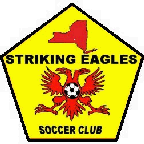 |
STRIKING EAGLES SOCCER CLUBPO Box 34, Gilbertsville, NY 13776 E-mail rwingjr@citlink.net
|
|
Striking
Eagles Home Page |
|
|
|
The Control Zoneby Chris Ducar, SoccerPlus Goalkeeper School, www.goalkeeper.com Emphasis for Safe and Solid GoalkeepingControl Zone Definition: The range of saves that a goalkeeper is responsible for making on a high percentage basis. These include saves from the ground up and those that are within one step right and one step left of their starting position.
If a goalkeeper positions him/herself properly, they will notice that many more saves will be made in this "zone". Just as young strikers dream of breaking the back of the net with a blistering shot or pulling off the famed bicycle kick to win the match, so does a young goalkeeper enter the position with equally high expectations. I'm sure all of you have at one time or another dreamed of saving your team with endless (and of course spectacular) diving saves. Who hasn't? All of us deserve to be the hero after the hours of training and the failures that we have survived. Wanting the chance to show our stuff in a game in such an amazing fashion is understandable. But what about all of those other types of saves? The basket catch save that just skipped off the mud in front of you. The contour catch you held that was knuckling right to left and back again. The collapse dive /side contour catch that you held while two attackers were poised to bury the rebound. The high contour catch in a crowd at the top of the six on a vicious cross. One of the most important lessons I learned about goalkeeping at a very early stage was that competence with these most basic of catches were highly valued to teammates and to the knowledgeable coach or scout. Many fans, coaches, and players (even goalkeepers) believe that the spectacular save equals great goalkeeping. But the coach that had the most impact on how I focused my training (David Brcic), convinced me that that was not where I should spend a large percentage of my training hours. He was more concerned with developing a technically solid goalkeeper. What makes a goalkeeper "solid"? David explained his philosophy on solid goalkeeping in this way: In a game, a large percentage of playable balls are either hit right at the goalkeeper or within one step left or right (this assumes, of course, proper positioning and angle play). When we see a goalkeeper making a diving save it is usually because one of two things has occurred: The shot was hit away from the keeper with power and accuracy OR the goalkeeper was out of position. Think of some of the "great" saves that you have made at your level of play. Was it really necessary to dive in that situation? Had you used good footwork to get in the best possible position to field the shot? Be honest! Most of us can usually answer NO in many of these situations. How many have dived for an easy ball just so that the save would look good? These are all common occurrences, and not just at the youth level mind you! Here are a few more words of wisdom from David: If a save looked difficult, it probably was. and: The more movement involved in a save, the more chance for an error. Does this make sense? I truly believe that it does. Think about the diving drills that you have experienced at camp. When executing a collapse dive, we stay in contact with the ground at all times and try to take the ball (and our body) to the ground as softly as possible. Compare this with extension diving over the "pony." Remember when you dove for the ball that your coach served you and then how it felt as you landed unceremoniously in a painful heap on the other side? I can almost guarantee that the ball did not end up in your possession. So not only did you not possess the ball, you inflicted quite a bit of pain upon yourself. The goalkeepers that train with me year round know all about the control zone and understand that it is the foundation to the whole position. My main focus is on relaxation and making the difficult saves look easy. This has a psychological component also. If the striker hits a shot with pace and movement and the keeper steps behind it and catches it with no overt signs of difficulty or effort, what will that striker try to do on the next shot? Probably try to kick it harder! By this time he/she has probably lost accuracy on the shot and the ball ends up going high or wide. So remember, while extension diving is a save that we must be able to pull out of our bag of tricks occasionally, we would be doing ourselves a disservice if that was a main focus of our training on a daily basis. |
|